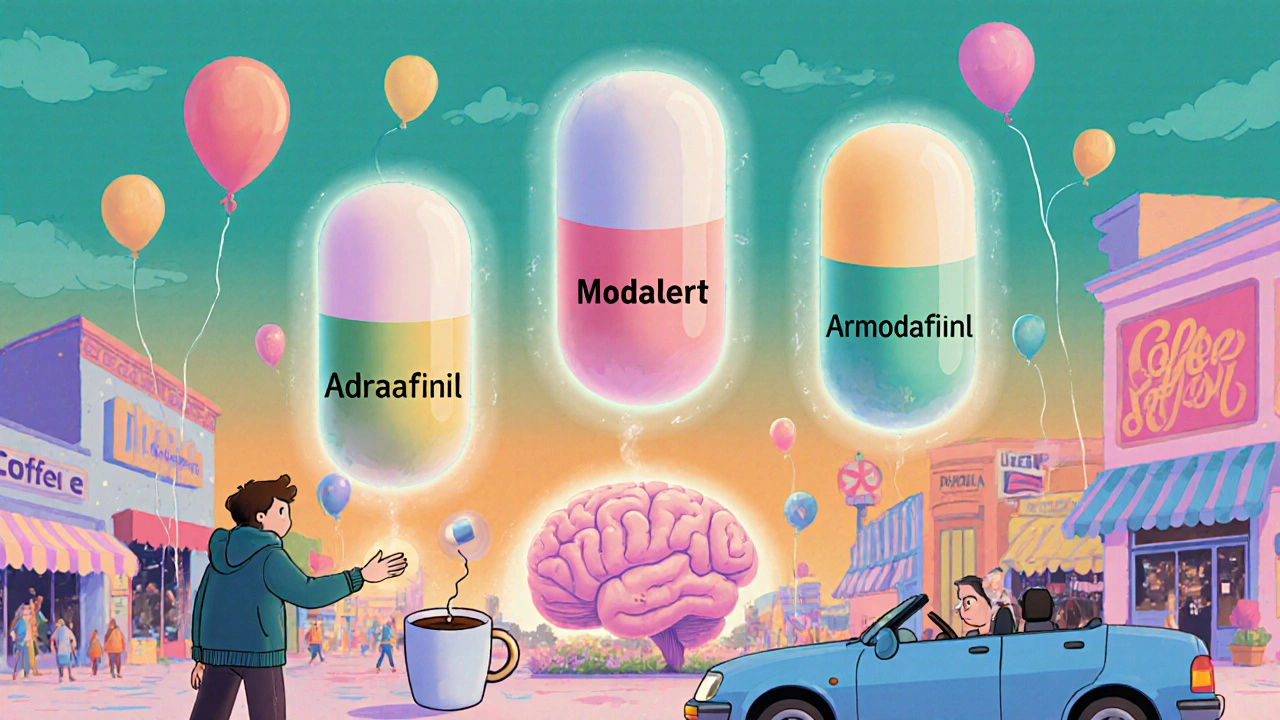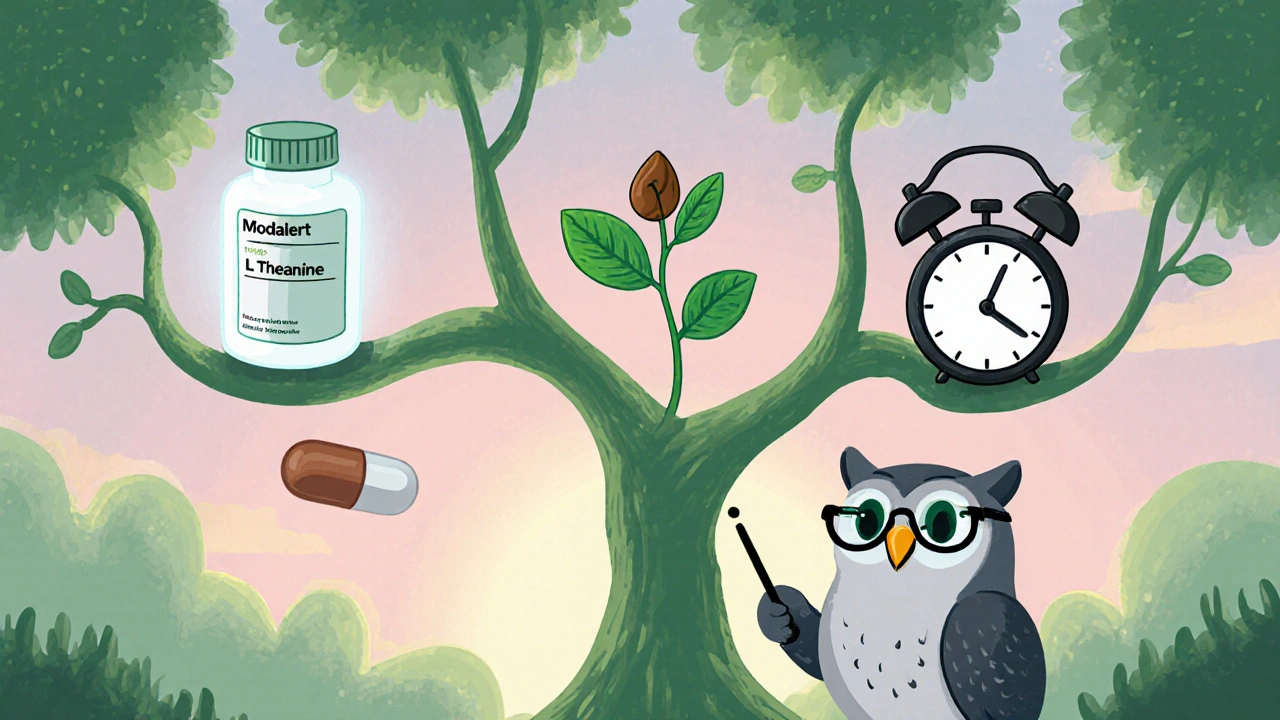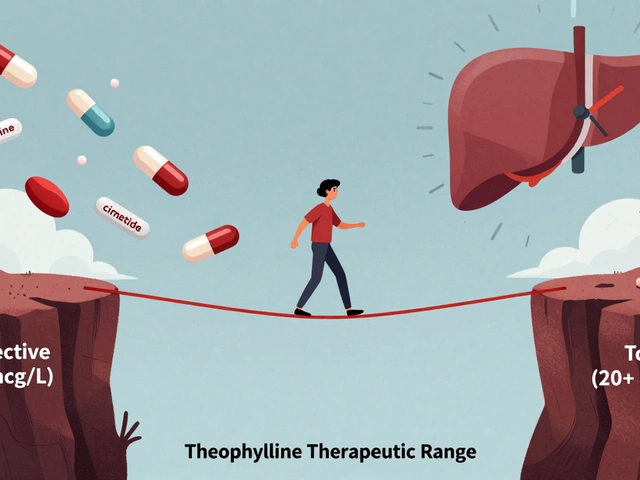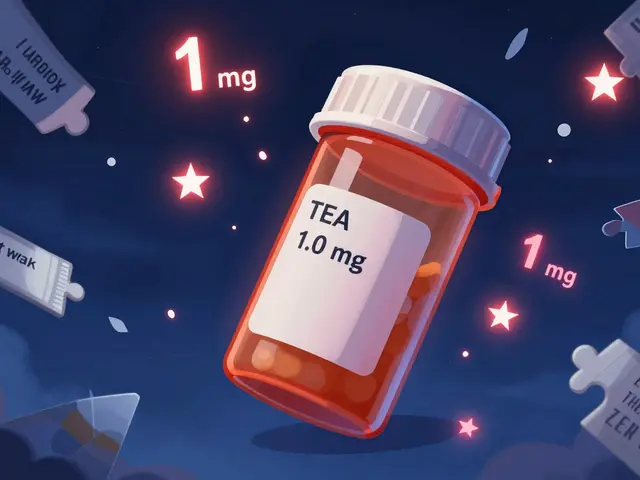
Wake-Boost Agent Selector
Choose your priority criteria
Select the most important factor for your situation to find the best wake-boosting agent for you
Recommended Wake-Boosting Agents
Modalert is the trade name for Modafinil, a prescription medication approved for narcolepsy, shift‑work sleep disorder and obstructive sleep‑apnea‑related fatigue. It belongs to the class of eugeroics - drugs that promote wakefulness without the jittery buzz of classic stimulants.
When you start looking for a pick‑me‑up for study sessions, long‑haul drives or simple afternoon slumps, you’ll quickly see a crowded market of alternatives. Some are prescription‑only, others are over‑the‑counter, and a few sit in the gray zone of research chemicals. This guide breaks down the most talked‑about options, compares them side‑by‑side, and helps you decide which (if any) fits your schedule, health profile and legal constraints.
How Modalert Works - The Science Behind the Wake‑Up Call
Modafinil’s exact mechanism isn’t fully nailed down, but three key actions are well documented:
- It raises extracellular dopamine by inhibiting the dopamine transporter (DAT), boosting alertness without the rapid spikes seen in amphetamines.
- It enhances histamine release in the hypothalamus, a neurotransmitter that directly drives arousal.
- It modulates orexin (hypocretin) pathways, which are central to maintaining stable wakefulness.
Because it works gently on dopamine and leans heavily on histamine and orexin, users report clear focus, reduced “brain fog”, and a low incidence of anxiety or heart‑rate spikes - qualities that set it apart from traditional stimulants.
What to Compare - Decision Criteria
Before we jump into the table, here are the five factors most people weigh when choosing a wake‑boost agent:
- Legality & prescription requirement - Is a doctor’s script needed, or can you buy it over the counter?
- Onset & duration - How fast does it kick in and how long does the effect last?
- Side‑effect profile - Headache, insomnia, anxiety, cardiovascular impact?
- Cost per dose - Prescription price vs. black‑market or supplement price.
- Interaction risk - Does it play nicely with other meds, caffeine or alcohol?
These criteria will be reflected in the comparison chart below.
| Agent | Legal status (2025) | Typical dose | Onset | Duration | Common side‑effects | Approx. cost per dose (USD) |
|---|---|---|---|---|---|---|
| Modalert (Modafinil) | Prescription only (USA, EU, AU) | 100‑200 mg | 30‑60 min | 12‑15 h | Headache, nausea, mild insomnia | $0.30‑$0.60 |
| Armodafinil (Nuvigil) | Prescription only | 150 mg | 45‑90 min | 12‑15 h | Dry mouth, dizziness, anxiety | $0.45‑$0.80 |
| Adrafinil | Over‑the‑counter (supplement) | 300‑600 mg | 60‑120 min | 10‑12 h | Liver enzyme elevation, headache | $0.20‑$0.35 |
| Methylphenidate (Ritalin) | Prescription only | 10‑30 mg | 20‑30 min | 3‑5 h | Appetite loss, tachycardia, insomnia | $0.50‑$1.00 |
| Caffeine | \nOTC worldwide | 100‑200 mg (≈1 cup coffee) | 5‑15 min | 3‑5 h | Jitters, increased heart rate, GI upset | $0.05‑$0.10 |
| L‑Theanine + Caffeine combo | OTC supplement | 200 mg L‑Theanine + 100 mg caffeine | 15‑30 min | 4‑6 h | Rare; may reduce caffeine jitters | $0.15‑$0.25 |

Deep‑Dive into Each Alternative
Below we unpack the pros and cons of each option, focusing on the five decision criteria introduced earlier.
Armodafinil (Nuvigil)
Armodafinil is the R‑enantiomer of Modafinil, meaning it’s a single‑molecule version of the racemic mix in Modalert. The result is a slightly longer half‑life, which can be a blessing for night‑owls who need to stay up past midnight. Side‑effects are comparable, though some users report more pronounced dry mouth.
Because it’s prescription‑only in most markets, cost is usually higher than generic Modalert, but insurance may cover it for diagnosed sleep‑disorder patients.
Adrafinil
Adrafinil is the pro‑drug that the liver converts into Modafinil. It’s sold as a dietary supplement in some countries, making it accessible without a doctor’s note. The catch? Your liver does more work, so long‑term use can elevate ALT/AST enzymes. Monitoring liver function every few months is advised.
Onset is slower (often a full hour) and you may need a slightly higher dose to match Modalert’s alertness levels. For occasional use, especially when a prescription isn’t practical, it’s a decent stand‑in.
Methylphenidate (Ritalin)
Technically a stimulant, not a eugeroic. It floods the brain with dopamine and norepinephrine, delivering a sharp boost in focus. The effect is noticeably more “wired” and can trigger anxiety or appetite suppression.
Its short duration (3‑5 h) means you may need multiple doses for a full workday, increasing the risk of rebound fatigue. It’s only legal with a prescription, and abuse potential is higher than Modalert.
Caffeine
The world’s most popular wake‑up aid. It works by blocking adenosine receptors, which normally tell your brain it’s time to rest. The effect is quick but also short, and tolerance builds fast - you’ll need more coffee for the same kick.
Side‑effects are well‑known: jitteriness, heart‑palpitations, and a possible crash once the caffeine wears off. For a light‑to‑moderate boost, it’s unbeatable in price and accessibility.
L‑Theanine + Caffeine combo
L‑Theanine, an amino acid found in tea, smooths out caffeine’s edge. Users report a calmer focus, less “wired” feeling, and fewer crashes. The combo is a favorite among gamers and students who need sustained attention without the shakiness.
Because both ingredients are OTC, you can tweak the ratio to suit your tolerance. It’s not as potent as Modalert, but it’s a safe, legal, and inexpensive alternative for mild alertness.
Safety, Interactions, and Legal Snapshot
Even though the wake‑boost market feels like a free‑for‑all, you still need to mind a few red flags:
- Drug interactions: Modafinil and Armodafinil can increase the metabolism of hormonal contraceptives, reducing effectiveness. They also raise levels of certain antidepressants, so a doctor’s green light is key.
- Liver health: Adrafinil’s conversion process can stress the liver. Anyone with hepatitis, fatty liver disease, or chronic alcohol use should avoid it.
- Cardiovascular warning: Stimulants like Methylphenidate raise blood pressure and heart rate. If you have hypertension or arrhythmia, skip them.
- Dependency risk: Classic stimulants (Ritalin, amphetamines) carry a higher abuse potential than eugeroics. Modalert sits in a middle ground - dependence is possible but rarer.
From a legal angle, the United States classifies Modafinil as a Schedule IV substance, meaning it’s controlled but not as tightly as amphetamines. In Australia, it’s a Schedule 4 prescription‑only drug. The UK’s Medicines and Healthcare products Regulatory Agency (MHRA) also requires a prescription. Always verify your local regulations before ordering online.

Choosing the Right Agent for Your Lifestyle
Here’s a quick “if‑then” guide to help you decide:
- If you need a long‑lasting, clear‑headed boost and have a prescription, Modalert is the go‑to.
- If you’re a night‑shift worker who can’t afford a prescription, Adrafinil offers similar wakefulness at the cost of occasional liver monitoring.
- If you want the strongest focus for a short window (e.g., a 2‑hour exam), Methylphenidate may serve, but be ready for side‑effects.
- If you prefer a legal, cheap, and low‑risk option for occasional coffee‑replacement, go with Caffeine or the L‑Theanine + Caffeine combo.
- If you need a mid‑range boost with a prescription but want a slightly longer half‑life, consider Armodafinil.
Remember, personal tolerance varies. Start with the lowest effective dose, keep a journal of sleep, mood, and side‑effects, and adjust accordingly.
Frequently Asked Questions
Is Modalert safe for healthy adults?
When taken as prescribed (100‑200 mg daily) and screened for cardiovascular issues, Modalert has a good safety record. Common mild side‑effects include headache and nausea. It’s not recommended for pregnant or breastfeeding women.
Can I stack Modalert with caffeine?
Yes, many users combine a cup of coffee with Modalert to shave off the onset time. However, too much caffeine can increase jitteriness, so keep the coffee to one small cup.
How does Adrafinil compare to Modalert in terms of liver impact?
Adrafinil requires hepatic conversion to Modafinil, which can raise liver enzyme levels after weeks of daily use. Periodic blood tests are advised. Modalert bypasses this step, making it gentler on the liver.
Is the L‑Theanine + caffeine combo as effective as Modalert?
The combo improves alertness and reduces caffeine‑induced jitters but doesn’t reach the same level of sustained wakefulness that Modalert provides. It’s best for light‑to‑moderate tasks, not for marathon study sessions.
What should I do if I experience insomnia after taking Modalert?
Take the dose early in the morning (no later than 9 am). Avoid other stimulants in the afternoon, limit screen exposure before bed, and consider a short “drug holiday” to reset your sleep cycle.
Whether you choose Modalert, an over‑the‑counter supplement, or a classic stimulant, the key is to match the agent’s profile to your needs, health status, and legal environment. Use the table, weigh the side‑effects, and start low. With the right choice, you’ll stay sharp without paying the price of unwanted crashes.






4 Comments
When you parse the pharmacodynamics of Modalert you instantly confront the triadic interplay between dopaminergic reuptake inhibition, histaminergic arousal pathways, and orexinergic modulation-each axis contributing a quantifiable uplift in cortical activation. The literature consistently quantifies the resultant wake‑maintenance as a statistically significant increase in mean reaction time metrics, without the catecholaminergic turbulence typical of amphetamine analogues. In practice this translates to a robust, low‑variance cognitive envelope that can be leveraged across high‑stakes operational environments. Clinicians therefore prescribe Modalert with a confidence interval that reflects both efficacy and a tolerable adverse‑event profile, provided you adhere to the recommended titration schema.
/p>The battlefield of wake‑boosters feels like a circus of half‑baked promises, each vendor shouting louder than the last while the underlying science huddles in the shadows. The drama of marketing hype often eclipses the quiet reliability of a well‑studied eugeroic. In the end the only thing that matters is whether the substance aligns with your personal tolerance and schedule.
/p>Modafinil sits at the intersection of neuropharmacology and lifestyle engineering. Its mechanism is not a mystery but a mosaic of subtle interactions. Dopamine reuptake inhibition gives a smooth lift unlike the rollercoaster of amphetamines. Histamine release in the hypothalamus adds a steady wakefulness signal. Orexin modulation locks that signal in place for hours. The net effect is a clarity that feels like mental glass. Users often report a drop in background noise of thought. This allows focus on a single thread without distraction. The drug’s half life stretches beyond twelve hours. That duration can be both a blessing and a curse. Early morning dosing means the tail can spill into nighttime sleep. Adjusting the clock of ingestion is a simple lever. Side‑effects such as headache tend to be mild and transient. Liver function remains stable for most healthy adults. In the end the decision rests on how your schedule aligns with the drug’s rhythm.
/p>That synopsis captures the core pharmacology well and adds a practical dosing reminder that many overlook.
/p>